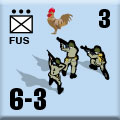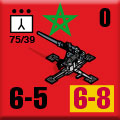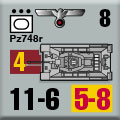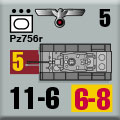1942: Moroccan Division
The Pieces
by Mike Bennighof, Ph.D.
August 2023
 Our Panzer Grenadier expansion 1940: Swallows of Death is all about the exploits of France’s toughest division – the 1st Moroccan Division – in the 1940 campaign. It’s built around a set of scenarios designed by Philippe Léonard and developed by Daniel Rouleau. But with all of our expansion books, I look for a rough balance between scenarios and story. So, about half of the book is devoted to the history of French Morocco and France’s Moroccan troops. I’m extraordinarily pleased with the book; that’s the balance we try to strike between history and game-play. Our Panzer Grenadier expansion 1940: Swallows of Death is all about the exploits of France’s toughest division – the 1st Moroccan Division – in the 1940 campaign. It’s built around a set of scenarios designed by Philippe Léonard and developed by Daniel Rouleau. But with all of our expansion books, I look for a rough balance between scenarios and story. So, about half of the book is devoted to the history of French Morocco and France’s Moroccan troops. I’m extraordinarily pleased with the book; that’s the balance we try to strike between history and game-play.
As I wrote the background, I of course included the weaponry fielded by the Moroccans. Unlike some other colonial powers, like the British, Americans and Italians, the French did not stint on arming their colonial troops. The Moroccans had the best weapons the French Army could give them: the modern MAS36 bolt-action rifle, the Brandt 81mm mortar, and the APX 47mm Puteaux Arsenal anti-tank gun. They also fielded the same Great War-era artillery and heavy machine guns that metropolitan French troops had been issued.
The French Army had hesitated to completely re-arm its troops, because of its training cycle. The “active” divisions were not front-line formations as their label might hint, but a mixture of professional cadre and recruits undergoing training. Thanks to the massive casualties of the Great War, successive French governments agreed that they wanted conscripts to serve a minimal time with the colors so that they could return to the civilian economy as quickly as possible. In time of war, the French Army would depend on these men to fill out reserve formations and fight on the front line.
To make that really work, the weapons on which they had trained had to stay in service. The French generals knew that the venerable 75mm field gun, Madame Soixante-Quinze, had been surpassed by the lightweight howitzers fielded by the Germans. But their artillery regiments depended on reservist gunners, and those reservist gunners had not been trained to operate new weapons like the Schneider 105mm howitzer. And so those only went to the mechanized outfits, which did have a much larger full-time cadre.
As war approached, the French generals realized that they had fallen behind the Germans in terms of weapons technology, and raced to catch up. New weapons, everything from rifles to heavy cannon, came off the drawing boards and started production. The reservists would have to be called up and trained with this materiel, and that would be expensive, but the alternative was unthinkable.
In our actual history, few of those weapons made it to the front lines, with trained operators, in time to make a difference. France fell in six weeks, despite hard fighting by not just the Moroccans but many French formations. But how would those battles have gone, had the French been given the breathing space to produce these weapons and train their soldiers to use them?
That’s the premise of 1942: Moroccan Division, an expansion set for Swallows of Death giving the Moroccans many of those drawing board or prototype weapons. It comes in download format, which means that you’ll have to assemble the pieces yourself. It’s free to the Gold Club, or you can pay $15.99 to download it at Wargame Vault if you’re still stubbornly resisting joining.
The scenarios take place in our Long War alternative history, the same setting as our 1942: The Defense of France expansion. Germany has attacked the Soviet Union in 1940 rather than France and the Low Countries, eventually subduing the Soviets after a two-year campaign. In September 1940 they turn to the West, but the French Army has had two years to issue new weapons and fully train its reservists. Will that be enough to overcome German combat experience?
Let’s have a look at all of that improved Moroccan firepower:
Infantry
 
The Moroccans went to war in 1940 with France’s newest battle rifle, the MAS36. It was a boxy, unattractive and very rugged weapon, a bolt-action magazine rifle holding five rounds. It had been carefully designed based on the experience of the Great War to make it easy to load and fire, easy to clean and easy to maintain.
The MAS40 was a semi-automatic version, a handful of which made it to the front in March 1940 for battle testing. It also had a five-round magazine; later versions doubled this to ten rounds. Like the MAS36 it was extremely rugged, but arrived too late to influence the Battle of France.
The FUS (“Fusilier”) platoon is simply a French infantry platoon with the MAS40. The French had a solid organization for their infantry; their problems came from that training cycle and the unfortunate fact that their reservists tended to forget their lessons after a decade away from their active service.
Anti-Tank Guns
 
The 47mm APX anti-tank gun appears in 1940: The Fall of France and 1940: Swallows of Death. On paper, at least, regimental anti-tank batteries had this extraordinarily effective weapon and battalion batteries had the less effective (but easy to handle) 25mm anti-tank gun.
By 1942, the 47mm APX has replaced the 25mm gun in the battalion batteries, and the regimental batteries have the new 75mm TAZ 39 anti-tank gun. The TAZ 39 had been developed from an anti-aircraft gun, and was one of the first weapons to use a discarding sabot round. Unusually for an anti-tank gun, it had all-round traverse. Only a few prototypes existed in 1940, but in 1942 it’s widely deployed and capable of destroying any German tank in the field.
Armored Fighting Vehicles
 
Where the Germans supported the infantry with specialized assault guns built on the same chassis as their medium tanks, the French deployed light tanks in both brigades that formed their armored divisions and also in independent battalions parceled out to the infantry divisions. Criticized by post-war popularizers as a foolish strategy of deploying tanks in “penny packets,” it was no different in concept than that of the Germans with their assault guns or Americans with their separate tank battalions. The light tanks were intended to be relatively cheap to manufacture precisely so they could be parceled out along the front to aid in the defense of France. The bigger, more capable tanks would equip the armored divisions.
By 1942, we’ve posited that each French first-line infantry division would include its own organic tank battalion; this seems to have been their intent. The Moroccans, having priority in receiving new weapons, field the AMX38 light tank, a vehicle designed for infantry support. It has a 47mm gun derived from the APX anti-tank gun, good speed and reasonable protection. While there were Moroccan armored units in World War II, they were Moroccan in name only and most personnel came from metropolitan France. That probably would have been the case in our alternative world as well.
The Moroccans also receive the W15 tank destroyer to provide some mobile defense. This was a wartime expedient mating the 47mm APX with the Laffly artillery tractor, and proved very successful in its limited combat run in 1940.
The Germans
 
The Germans get some new stuff, too, in the form of Soviet-made tanks modified with German armament as well as radios, optics and engines. This happened on a small scale during the actual war, with most of the captured tanks coming from the battlefield and repaired or refurbished for German use (some T34 tanks were taken directly from the factory when the Kharkiv Locomotive Works fell to the Germans).
Not many such tanks received new armament; there’s only photographic evidence for one KV-1 heavy tanks with a German 75mm KwK40 L/43 gun in place of its factory-supplied ZiS5 76.2mm gun:

In our alternative history, however, the Soviet Union has been defeated and at its factories turned to German use, with KV tanks rolling off the lines in Leningrad and T34 medium tanks in Kharkiv. That provides T34 (Pz748r) and KV-1 (Pz756r) tanks for the panzer divisions fighting in France in late 1942. The Germans labelled the re-armed KV as Pz756r (the unmodified model was the 755r); the T34 with standard main gun went by 747r so we’ve changed its number to match (there was an actual 748r, the SU85 assault gun, but it would not have been produced during the time of our alternative history).
Nazi Germany was not the industrial powerhouse that Imperial Germany had been; it could not supply its armed forces with tanks, guns, and vehicles at the scale its war machine demanded and the actual campaign against the Soviet Union depended on captured equipment, chiefly Czech-made tanks and French-made trucks and tanks. That’s the same case here, only its Soviet-made gear being turned against France.
Summary
It’s not for everyone, but for the hard-core Panzer Grenadier player, 1942: Moroccan Division lets you play with the drawing-board weapons that allow the French to stand up to the Germans toe-to-toe. You’ll need 1940: The Fall of France, 1940: Swallows of Death, and 1940: The Defense of France (also a downloadable expansion) to play all of the scenarios included.
You can download 1942 Moroccan Division right here.
It’s $15.99, but if you’re a Gold Club member, it’s free to you as part of the Golden Library (there’s no Gold Club discount or freeness through Wargame Vault).
Click here to join the Gold Club
See your Gold Club Insider newsletter for ordering information.
La Campagne 1940
1940: Road to Dunkirk (boxed)
1940: The Fall of France (Playbook ed)
1940: The Last Days of May
1940: Swallows of Death
Retail Price: $247.96
Package Price: $200
Gold Club Price: $160
You can order La Campagne 1940 right here.
This package qualifies for Gold Club Free Shipping (another $36 off!)
Golden Chipboard
 Ten (10) chipboard sheets, slightly thicker than the ones we use for game pieces, for use in pasting up your own counters from our downloadable games and expansions. Ten (10) chipboard sheets, slightly thicker than the ones we use for game pieces, for use in pasting up your own counters from our downloadable games and expansions.
You can order Golden Chipboard right here.
Sign up for our newsletter right here. Your info will never be sold or transferred; we'll just use it to update you on new games and new offers.
Mike Bennighof is president of Avalanche Press and holds a doctorate in history from Emory University. A Fulbright Scholar and NASA Journalist in Space finalist, he has published an unknowable number of books, games and articles on historical subjects.
He lives in Birmingham, Alabama with his wife, three children and his new puppy. He will never forget his dog, Leopold, Leopold knew the number.
Want to keep Daily Content free of third-party ads? You can send us some love (and cash) through this link right here.
|
